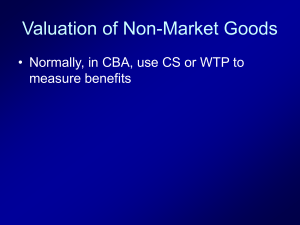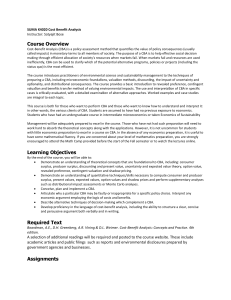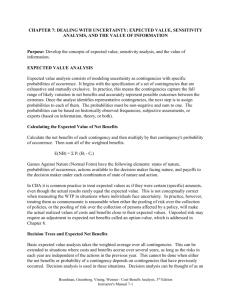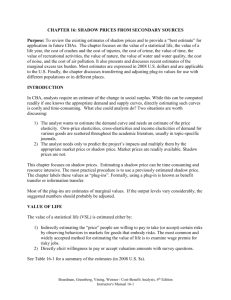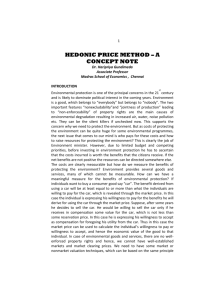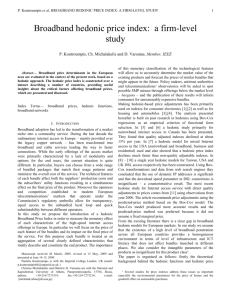CHAPTER 13: VALUING IMPACTS FROM OBSERVED BEHAVIOR
advertisement
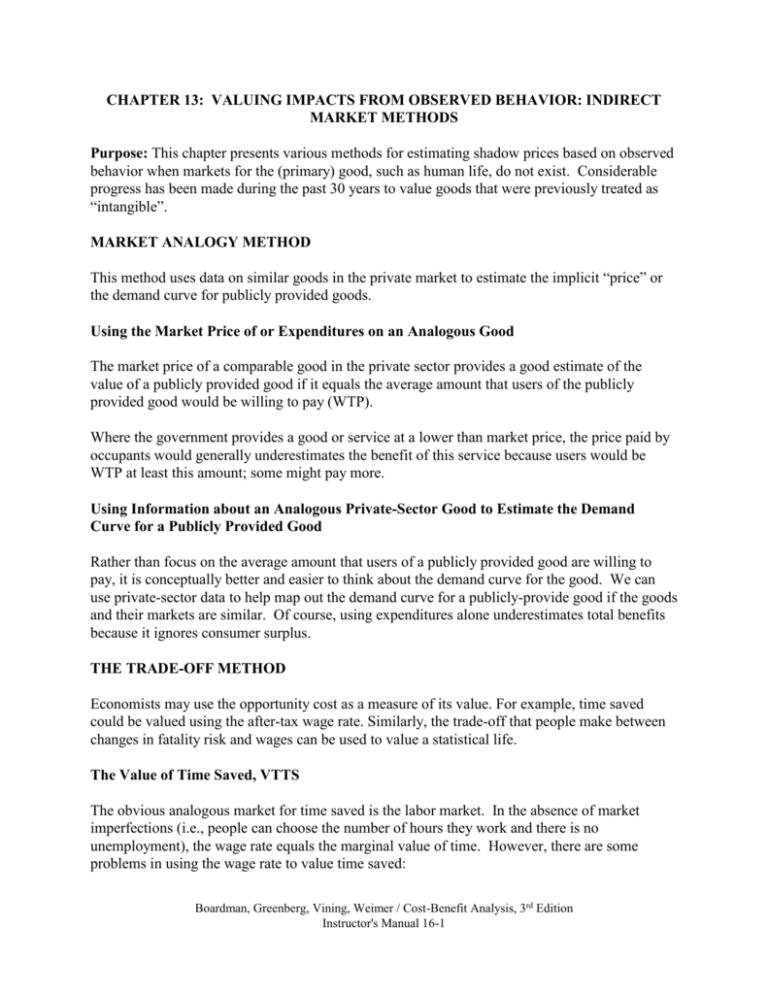
CHAPTER 13: VALUING IMPACTS FROM OBSERVED BEHAVIOR: INDIRECT MARKET METHODS Purpose: This chapter presents various methods for estimating shadow prices based on observed behavior when markets for the (primary) good, such as human life, do not exist. Considerable progress has been made during the past 30 years to value goods that were previously treated as “intangible”. MARKET ANALOGY METHOD This method uses data on similar goods in the private market to estimate the implicit “price” or the demand curve for publicly provided goods. Using the Market Price of or Expenditures on an Analogous Good The market price of a comparable good in the private sector provides a good estimate of the value of a publicly provided good if it equals the average amount that users of the publicly provided good would be willing to pay (WTP). Where the government provides a good or service at a lower than market price, the price paid by occupants would generally underestimates the benefit of this service because users would be WTP at least this amount; some might pay more. Using Information about an Analogous Private-Sector Good to Estimate the Demand Curve for a Publicly Provided Good Rather than focus on the average amount that users of a publicly provided good are willing to pay, it is conceptually better and easier to think about the demand curve for the good. We can use private-sector data to help map out the demand curve for a publicly-provide good if the goods and their markets are similar. Of course, using expenditures alone underestimates total benefits because it ignores consumer surplus. THE TRADE-OFF METHOD Economists may use the opportunity cost as a measure of its value. For example, time saved could be valued using the after-tax wage rate. Similarly, the trade-off that people make between changes in fatality risk and wages can be used to value a statistical life. The Value of Time Saved, VTTS The obvious analogous market for time saved is the labor market. In the absence of market imperfections (i.e., people can choose the number of hours they work and there is no unemployment), the wage rate equals the marginal value of time. However, there are some problems in using the wage rate to value time saved: Boardman, Greenberg, Vining, Weimer / Cost-Benefit Analysis, 3rd Edition Instructor's Manual 16-1 1) 2) 3) 4) 5) 6) First, wages ignore benefits. As benefits are a form of compensation for work, they should be added to wages. People could be working while traveling or waiting and, therefore, time saved would be worth less than the wage rate (plus benefits). It should take account of taxes and, for people who are not working, use the after-tax wage rate (plus benefits). People value different types of time differently. Importantly, many people enjoy traveling. The wage rate may not be appropriate due to rigidities in the market or market failures. For example, people may not be able to easily adjust the number of hours they work. Firms may not pay employees their marginal social product. In conclusion, using the wage rate is only a first approximation. The Value a Statistical Life, VSL Forgone earnings method - This method suggests the value of a life saved equals the person’s discounted future earnings. It generates higher values for young, high-income males than old, low-income females. For retired people, the resultant value of life may be negative. Conceptually, the main problem with this method is that it does not reflect what people are WTP for a small reduction in risk of their death. Simple Consumer Purchase Studies - This method estimates the value of life by observing how much people pay for life-saving devices, such as safety belts. If people are willing to pay an extra $300 to reduce the probability that they will die by 1/10,000, then they value life at $3 million. Simple Labor Market Studies - Similarly, if a person is willing to forgo an extra $3,500/yr to increase the probability that he will not have a fatal on-the-job accident by 1/1,000, then he values his life at $3.5 million (or more). The imputed value of life varies according to the initial risk and the additional level of risk people are asked to assume due to diminishing marginal utility for safety. Problems with Simple Consumer and Wage-Risk Studies These methods assume workers and consumers fully understand the risks, which they may not. They also assume that people in the studies are representative of the population, while they may not be. For example, people who take risky jobs may be may like to take risks which would lead to a relatively small gap in the salary between risky and less-risky jobs. Third, they assume that researchers have accurate measures of the risks. Fourth, the willingness to pay to reduce risk depends on the level of risk. Also, this method assumes that the relevant markets are efficient and all other variables are constant (no omitted variable problem). Boardman, Greenberg, Vining, Weimer / Cost-Benefit Analysis, 3rd Edition Instructor's Manual 16-2 INTERMEDIATE GOOD METHOD If a project produces an intermediate good that is not sold in a well functioning market, then its value can be imputed by determining the value added to the “downstream activity”: Annual Benefit = NI(with project) – NI(without project) where, NI = net income of downstream business. The total benefit of a project can be computed by discounting these annual benefits over the project’s life. This method can be used to value improvements in human capital, such as training programs, by comparing the average incomes of those in the program to those who are not. Some problems with this method are: 1) It assumes the difference in income captures all of the benefits (there may be consumption benefits) 2) It assumes all other variables are held constant (e.g., ability). ASSET VALUATION METHOD The impacts of a project or policy can be imputed from changes in the price for certain capital goods. For example, the “value” of noise can be inferred from comparing the price of a house in a noisy neighborhood to the price of a similar house in a quiet neighborhood. Changes in the market values of firms following a regulatory change can be used to estimate the change in producer surplus of the new regulations (an event study). An advantage of using prices is that information is quickly and efficiently capitalized into prices so that price changes or price differences provide a good estimate of the value of the policy change. Also, appropriate data are often available in machine readable form. PROBLEMS WITH SIMPLE VALUATION METHODS All of the methods discussed above suffer potentially from the omitted variable problem and selfselection bias. THE HEDONIC PRICE METHOD The hedonic price method (sometimes called the hedonic regression method) can be used to value an attribute, or a change in an attribute, whenever its value is capitalized into the price of an asset, such as houses or salaries. This method offers a way to overcome problems from omitted variables and self-selection bias. It consists of two steps. Suppose one wants to estimate the value of a scenic view. The first step estimates the effect of a marginally better scenic view on the value (price) of houses (a slope parameter in a regression model), while controlling for other variables that affect house prices. For example, we may postulate the following multiplicative model: Boardman, Greenberg, Vining, Weimer / Cost-Benefit Analysis, 3rd Edition Instructor's Manual 16-3 P = 0 CBD 1 SIZE 2 VIEW 3 NBHD 4 e (13.2) This equation is called a hedonic price function or implicit price function. The change in the price of a house that results from a unit change in a particular attribute (i.e., the slope) is called the hedonic price, implicit price, or rent differential of the attribute. In a well-functioning market, the hedonic price can naturally be interpreted as the additional cost of purchasing a house that is marginally better in terms of a particular attribute. For example, the hedonic price of scenic views, which we denote as rv, measures the additional cost of buying a house with a slightly better (higher-level) scenic view. For the above multiplicative model: rv = 3 P >0. VIEW (13.3) The second step estimates the WTP for scenic views, after controlling for “tastes,” which are proxied by income and other socioeconomic factors. To account for different incomes and tastes, analysts should estimate the following WTP function (inverse demand function) for scenic views: rv = W(VIEW, Y, Z) (13.5) where, rv is estimated from equation (13.3), Y is household income, and Z is a vector of household characteristics that reflects tastes (e.g., socioeconomic background, race, age, and family size). Using the methods described in Chapter 4, it is straightforward to use equation (13.5) to calculate the change in consumer surplus to a household due to a change in the level of scenic view. These changes in individual household consumer surplus can be aggregated across all households to obtain the total change in consumer surplus. Problems with Hedonic Models There are several potential problems with hedonic models. First, people must know and understand the implications of the attribute that is being valued. For example, people should know the level of pollution at the property they buy and know the expected effect of this level of pollution on their health. Second, variables should be measured without error (the errors in variables problem). Third, the functional forms should be correct (specification error problem). Fourth, the market should have enough alternatives so that people can locate at their optimum point on the curve. Fifth, there may be multicollinearity problems, e.g., fatality risk and nonfatality risk might be highly correlated. Dropping one variable would lead to an omitted variable problem. Sixth, markets are assumed to adjust immediately to changes in the attributes of interest and to all other factors. Boardman, Greenberg, Vining, Weimer / Cost-Benefit Analysis, 3rd Edition Instructor's Manual 16-4 TRAVEL COST METHOD Most applications of the travel cost method (TCM) have been to value recreational sites. Suppose that we want to estimate the value of a particular recreational site. We expect that the quantity of visits demanded by an individual, q, depends on its price, p; the price of substitutes, ps; the person’s income, Y; and variables that reflect the person’s tastes, Z: q = f(p,ps,Y,Z) (13.7) The TCM recognizes that the full price paid by persons for a visit to a recreational site is more than just the admission fee. It also includes the costs of traveling to and from the site. Among these travel costs are the opportunity cost of time spent traveling, the operating cost of vehicles used to travel, the cost of accommodations for overnight stays while traveling or visiting, and parking fees at the site. The sum of all of these costs gives the total cost of a visit to the site. This total cost is used as an explanatory variable in place of the admission price in a model similar to equation (13.7). The clever insight of the TCM is that, although admission fees are usually the same for all persons (indeed, they are often zero), the total cost faced by each person varies because of differences in the travel cost component. Consequently, usage also varies, thereby allowing researchers to make inferences about the demand curve for the site Estimating the demand schedule (equation 13.7) for a particular recreational site is conceptually straightforward. First, select a random sample of households within the market area of the site. Second, survey these households to determine their numbers of visits to the site over some period of time, all of their costs involved in visiting the site, their costs of visiting substitute sites, their incomes, and other characteristics that may affect their demand. Third, specify a functional form for the demand schedule and estimate it using the survey data. It is worth emphasizing that when total cost replaces price in equation (13.7), this equation is not the usual demand curve that gives visits as a function of the price of admission. However, as shown in the next section, the TCM can be used to estimate the usual market demand curve. Zonal Travel Cost Method Using this method, researchers survey actual visitors rather than potential ones. Visitors are allocated to a particular zone, depending on their “travel costs” (usually distance). For each zone, the analyst computes the average number of visits per year and the average total travel cost. Using these observations it is possible to estimate the relationship between cost/trip and the number of trips per person. The consumer surplus for a visitor from a particular zone is given by the area below this curve and above the cost of a visit from that zone, as shown in Figure 13.4. By repeating this calculation for each zone, it is possible to calculate the total consumer surplus, as shown in Table 13.1. Boardman, Greenberg, Vining, Weimer / Cost-Benefit Analysis, 3rd Edition Instructor's Manual 16-5 It is also possible to estimate the market demand curve, which is shown in Figure 13.5, following the method described in the chapter. The consumer surplus may be obtained from the market demand curve in the usual way. Limitations of the TCM Limitations of the TCM are: 1) It is restricted to sites where people (in the zones) have different travel costs. Without variation in total cost, it’s hard to estimate a demand curve. 2) There may be analytical problems in measuring the total cost of a visit. How does one measure opportunity cost of travel time? Does one include the marginal cost of capital goods used at the site? Should multiple purpose trips be included in the data (desirable if costs can be accurately apportioned to the site)? Also, the journey may have value (and hence the trip has multiple purposes). 3) Travel cost may be endogenous not exogenous. People who plan to travel to the site frequently may choose to live near the site (hence number of visits and travel costs are determined simultaneously). OLS estimators could be biased. 4) There may be other econometric problems, such as truncation (drawing sample from only visitors rather than the population at large – resulting in biased results). Also, there may be omitted variables (if tastes or substitutes vary across zones). 5) The method estimates the WTP for the entire site rather than features of the site. It’s possible to value features if people in zones can choose among alternative sites with different attributes – by using the “hedonic travel cost method”, which treats total cost as a function of both distance from zone to the site and the various attributes of the site. DEFENSIVE EXPENDITURES METHOD A defensive expenditure is an expenditure in response to something undesirable, such as pollution. If smog improves (worsens) you may spend less (more) on having your windows cleaned. The change in expenditures can be used as a measure of the change in pollution. There are at least five problems with this method: 1) Reduced spending on a defensive expenditure underestimates the benefits of cleaner air. 2) It assumes people adjust quickly to the new equilibrium, such as new smog levels. 3) Defensive expenditure may not remedy entire the damage. 4) Defensive expenditures may have benefits other than remedying damage, which should be included. 5) Not all defensive expenditures are purchased in markets, for example, some people clean their own windows; changes in these “expenditures” should also be included. Boardman, Greenberg, Vining, Weimer / Cost-Benefit Analysis, 3rd Edition Instructor's Manual 16-6
